Japanese Design Archive Survey
DESIGN ARCHIVE
Designers & Creators
Takamichi Ito
Designer, Kinetic Sculptor
Date: 12 December 2023, 13:30-15:30
Location: MOV
Interviewees: Takamichi Ito
Interviewers: Yasuko Seki, Aia Urakawa
Writing: Aia Urakawa
PROFILE
Profile
Takamichi Ito
Designer, Kinetic Sculptor
1939 Born in Sapporo, Hokkaido
1961 Establishes MOV
1962 Graduates from Tokyo University of the Arts, Department of Metal Crafts
Designed the Christmas display for the Shiseido Kaikan
1963 Begins designing show window displays for Shiseido Kaikan (〜72)
1966 Participated in the exhibition "From Space to Environment"
1968 Invited to participate in outdoor sculpture exhibitions, starting with the National Museum of Modern Art, Kyoto, including the Contemporary Sculpture Exhibition at Suma Imperial Villa, Kobe and the UBE Biennale (Modern Japanese Sculpture Exhibition),Yamaguchi
1969 Exhibits at "Electromagica'69", participates in "Sandwich Silencer"
1970 Designed numerous pavilions for the Japan World Exposition, Osaka
Established LD Yamagiwa Laboratory and became its director (〜75)
1985 International Science and Technology Exposition (Tsukuba Expo'85), Theme Pavilion, works on display
Installation of outdoor artworks at the Sapporo Art Park Museum
1993 Appointed professor at the Department of Design, Faculty of Fine Arts, Tokyo University of the Arts (〜2006)
2000 Katsuhiro Yamaguchi and the founding of the Institute of Environmental Art and Design
2001 Appointed Vice-President of Tokyo University of the Arts, retired the same year
2004 Solo exhibition "Takamichi Ito: Dynamic Spatial Art", Shanghai
2006 Appointed professor emeritus at Tokyo University of the Arts; held the exhibition "Takamichi Ito" in commemoration of his retirement from Tokyo University of the Arts
Awards: ADC Awards (Gold, Silver, Bronze); Mainichi Industrial Design Award; Japan Sign Design Award Grand Prize; Japan Display Design Award Excellence Prize; Asahi Prize; Contemporary Sculpture Exhibition at Suma Imperial Villa, Kobe (Grand Prize, Excellence Prize, Kobe Citizen Award); the grand prize of the Hakone Open-air Museum, Grand Prize; the National Museum of Modern Art, Kyoto Award, Kukan Design Award (Grand Prize, Nikkei Award); etc.
Major collections: the National Museum of Modern Art, Kyoto; the Museum of Modern Art, Kamakura & Hayama; the Hokkaido Museum of Modern Art; the Hakone Open-Air Museum; the Sapporo Art Park; the Shimane Art Museum, SHISEIDO ART HOUSE, Moon Lake Sculpture Park, Shanghai; etc.
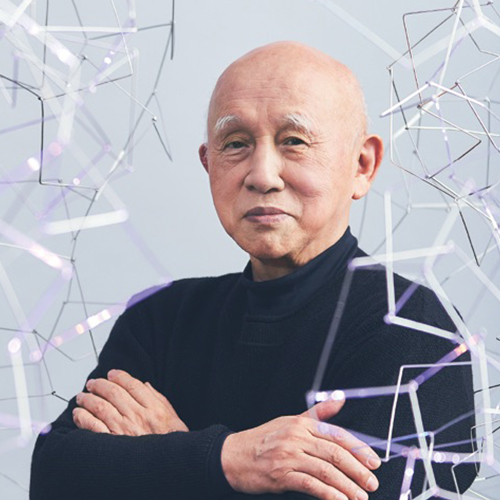
Description
Description
With his unique interpretation, Takamichi Ito has opened up a new world of sculpture-objects that straddle the realms of art and environmental design. His starting point was an encounter with a book by the American sculptor and contemporary artist Alexander Calder when he was a university student in the 1960s. He was fascinated by the "mobiles" that Calder had invented and produced, and from there he became obsessed with creating moving works of art. After graduating from university, his talent blossomed at once. In his early twenties, he came into the limelight with his Shiseido Kaikan show-window display design and the pavilion design for the Japan World Exposition, Osaka, and became the darling of the times. He has since expanded his field to include lighting, space, environment and urban design, while at the same time being active in the world of contemporary art and outdoor sculpture. Crossing the realms of design and art, it brought the art of dynamic light to the Japanese landscape. He has won numerous awards in both fields in recognition of his achievements.
Ito's creative process is rooted in the nature of his birthplace, Sapporo, Hokkaido. "The Hokkaido where I grew up changes dynamically with the seasons, especially in winter when it is covered in white, and the various light and movement effects stimulate my senses in abundance. Landscapes without boundaries and snow falling silently for days on end are part of the everyday landscape that unfolds around me. The light from the street lamps brightening the piles of snow and the discontinuous patterns of light from the windows of people's houses brought out endless stories. Like an ink painting, the loss of colour was replaced by "form" and "air". It seems that nature, which dilutes the presence of these objects, has accumulated in my sensibility". "Ito Takamichi 1960-2005", MOV(2006).
From 1993 to 2006, he taught at his alma mater, Tokyo University of the Arts, where he also devoted himself to teaching and research. He collaborated with the music faculty at the university's Sogakudo and also worked on operas and Japanese music stages. In recent years, he has held solo exhibitions and served on juries in China and Taiwan. Living through the pre-war and post-war years, Ito participated in exhibitions such as "From Space to Environment", "Electromagica'69", the Japan World Exposition, Osaka and "Sandwich Silencer", and is a valuable witness to the early days of design in Japan and has experienced first-hand the enthusiasm of this period. We visited Ito at his Tokyo studio, where he is still active in his creative activities, and spoke to him about his thoughts and ideas at the time, as well as about the materials used in his creative activities over the past 60 years, starting with his 1962 show-window display design for the Shiseido Kaikan and continuing to the present day.
Masterpiece
Masterpiece
Design:
Show-window display design for Shiseido Kaikan (1962-72); Pavilion design for Japan World Exposition, Osaka (Theme Pavilion, Japan Pavilion, RICOH Pavilion, Guest House, KUBOTA Pavilion, etc.) (1970); "8000 Pipes and Lights", Keio Plaza Hotel, Shinjuku (1971); Planning and design for Theme Pavilion, Northern Area Environmental Exposition, Sapporo (1974); Production planning and design of the Mitsui Children's Science Museum, at the International Ocean Exposition, Okinawa (1975); Planning and design of the "Sapporo White Lumination", Odori venue, Sapporo (held annually from 1980 to present), Planning and design of the Shibetsu Salmon Museum (1988), Art direction planning and design of the Tokyo Sea Life Park (1989), Torch stand design for the Sapporo Universiade Winter Games (1991)
Environmental sculpture:
"16 Rotating Bent Stick", the Hakone Open-Air Museum (1969); "Rotating Rings with Curved Lines", The Hakone Open-Air Museum(1975); "Rotating Spiral; January", Hokkaido Museum of Modern Art, Sapporo (1978); "Yarn; Loom; Man", Nishijin Textile Center, Kyoto (1978); "Yamata no Orochi", "Link Link Link", The International Exposition, Tsukuba, Ibaraki (1985); "Line of Sky and Earth", the Sapporo Art Park (1986); "Light Dancing", La Jolla Valley, California (1986); "Airline", ANA Hotel, Akasaka (1986); "Light; Acummulating", Shin-Urayasu Station Square, Urayasu (1989); "Wind; Surface of Water", Lake Toya Gurutto Chokoku Koen, Lake Toya (1990); "Gate of Light", NEC headquarters building, Mita (1990); "Rustling; Spring", "Rustling; Autumn", New Chitose Airport Lobby, Chitose (1992); Aichi Prefecture - Jiangsu Province Friendship Monument "Exchange Great Wheel", Nanjing, China (1993); "Four Rotations", Tongyeong International Open Air Sculpture Symposium, Tongyeong, Korea (1997); "Line; Light; Snow; Wind", Echigo Hillside Park, Nagaoka (1998); "Hikari, Dancing in the Sky", Wujiaoluyuan, Guilin, China (2005); "Arch of the Wind", Moon Lake Sculpture Park(2007); "three realms of existence", Teresa Teng Memorial Park(2024)
Stage design:
Opera "Ada", Sogakudo, Tokyo University of the Arts, Sogakudo, Ueno (2000); "Kumano no Monogatari", Tokyo University of the Arts, Sogakudo, Ueno (2002); "Taketori Monogatari" Tokyo University of the Arts, Sogakudo, Ueno (2003); "The Beauty of Japanese Music: The Japanese Music Epic "Susanowo", Tokyo University of the Arts, Sogakudo, Ueno (2005); "Ravel Project 6th "Uta" series V 1st opera evening" Tokyo University of the Arts, Sogakudo, Ueno (2005)
Books:
"the Sapporo Art Park Collection Contemporary sculpture collection 3 Ito Takamichi", the Sapporo Art Park(1987); "Ito Takamichi ugoku chokokuten", Takaoka Art Museum(1995); "Ito Takamichi ugoku chokokuten: Kaiten suru jikan", Takaoka Art Museum(1999); "Jikan o zoukeisuru – Ito Takamichiten", Art Department of the Takashimaya(2006); "Ito Takamichi 1960-2005", MOV(2006)
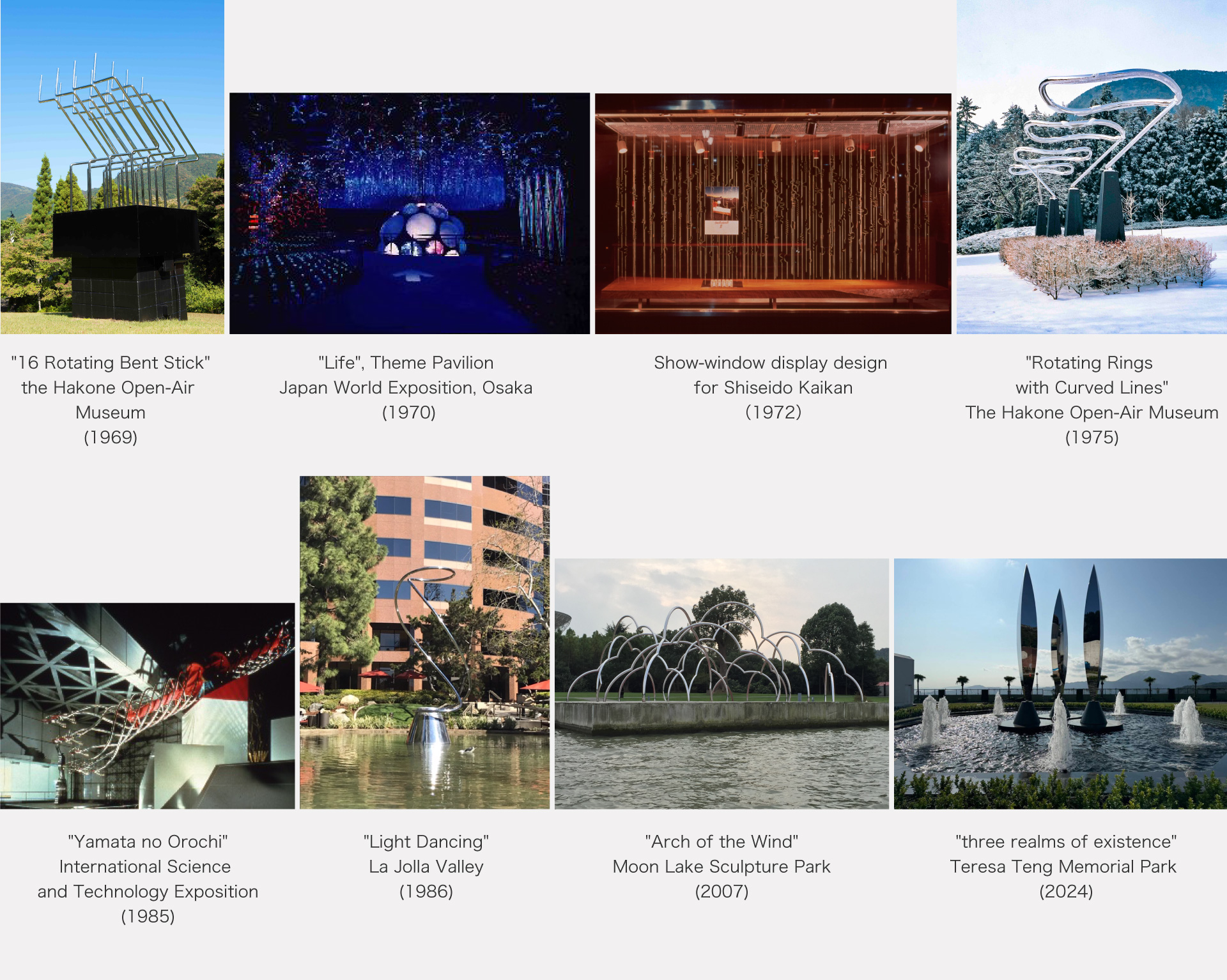
Interview
Interview
Times are changing, but I want to propose new creations
It was one Calder book that sparked my interest in this path
ー It's a fantastic atelier. Even though it is in the middle of Tokyo, you have a rich natural landscape in front of you and the autumn leaves are beautiful. When was this atelier built?
Ito In 1961, and in the 1980s I also built a atelier in Hokkaido. I designed both by myself. If you ask an architect to do it, they make it their own work. Architecture is absolutely interesting, so I felt that I couldn't let someone else do that.
ー The other day, designer Ms. Chiori Ito told us that she directed the exhibition "100 Years of Kikuichi - A Story of Town, Your father, Mr. Takaki, was the second generation of the caterer Kikuichi Honten, and the works of more than a dozen of his relatives were also on display. I was told by her that most of them are involved in manufacturing.
Ito Chiori is my niece and is based in Sapporo. Most of my relatives live in Hokkaido, I was born in Sapporo and I am the third son of six siblings. Chiori's father, Ryuichi, was six years older than me and is no longer deceased. My family used to be a caterer, or rather a cookery shop. My father was a bit of a strange man, he liked to make things, and he took the entrance exams to the Tokyo Fine Arts School (now Tokyo University of the Arts) twice but failed, so he took over the family business in tears. When my brother (Ryuichi) was in high school, my father told him that he was not ready to take over the business and that he should go to the Tokyo University of the Arts to study. Even though it's a restaurant, you don't just make food, you also learn about tableware. I think he also wanted to go to the Tokyo University of the Arts himself. My brother passed the entrance exam to the Tokyo University of the Arts and majored in lacquer art in the crafts department. I also loved making things since I was a child, doing crafts, drawing pictures and even doing sculpture when I was in primary school, copying my father. I did almost the same things as I do now. At the time, the word "design" was not yet common, and I didn't know anything about it until I entered the Tokyo University of the Arts, but I decided to follow my brother's footsteps and apply to the Tokyo University of the Arts. There were no preparatory schools in Hokkaido at the time, so my brother was my teacher for the entrance examinations. I drew a picture and sent it to my brother, who scored it and sent it back.
ー You majoured in metalwork at the Department of Crafts at the Tokyo University of the Arts, didn't you?
Ito I took a year off before entering the university, but I thought metalwork in the crafts department would be interesting. What I learnt about metal engraving there is still useful to this day.
ー I heard that you worked part-time at various architects' offices while you were at university.
Ito It was not a part time job where I was paid, but I just helped out with making models. I worked at Mr. Mayumi Miyawaki's office and Mr. Kisho Kurokawa's office, making models for competitions for the International Conference Centre and the National Theater. The person I helped most often was Mr. Kim Swoo Geun from South Korea. He studied architecture at the Tokyo University of the Arts under Mr. Junzo Yoshimura, and after completing his postgraduate studies at the University of Tokyo, he won first prize in the competition for the National Assembly of the Republic of Korea. I went to his office almost every day to help him make a model for that competition. His wife is Japanese, and she cooked a lot of Korean food for me, which was delicious. The Komtan soup was particularly tasty.
ー You started down this path after an encounter with Alexander Calder's book when you were at university.
Ito When I was working on an assignment in my second year, an American designer came to visit us. Since I was a child, there were many American Occupation Forces in uniform around town, but this was the first time I had seen a foreigner wearing a suit. He asked me to sell him an assignment piece I had made. It was a silver inlaid seal stand I had made in metalwork, and I engraved his name on the back. It was a silver inlaid seal stand I had made in metalwork, with my name engraved on the back. He took out a dollar note from his wallet, but I had never seen a dollar before and I didn't know how to convert it into Japanese yen, so I gave it to him as a "present", even though it was a piece of work for an assignment. He was so pleased that he later sent me five original books of the design in cardboard boxes as a thank you. It was a time when there was only one bookshop in Ginza that sold Western books in Japan. One of them contained a book by Alexander Calder. I was so intrigued that I asked the teacher, "What are these sculptures?" He said, "This is a mobile". I found the origins of my modelling in that mobile. After that, I imitated what I saw in the book and made various mobiles. My graduation project was also a mobile. That one book was the catalyst for the work I'm still doing today.
ー What attracted you to the mobiles? Was it the shape or the fact that it is suspended from the ceiling?
Ito The fact that they are suspended from the ceiling, so they are weightless, and the fact that they move with the wind. Mr. Arata Isozaki once told me that I was attracted to things without weight because I was born and raised in Hokkaido.
ー That was mentioned in the book, "Tukuru jutsu nitsuite 5 nin no dezainatachi to katatta – Miyawaki Mayumi taidansyu (Shinkenchiku-Sha, 1983) ". "I was in Kyushu, where there is a sharp contrast between light and shadow, while Mr. Ito was in the northern part of Japan, where there are no shadows and it's all white and sparkling.
Ito It's a matter of light. In the southern region where Mr. Isozaki was from, there are many evergreen trees, and the world is clearly divided into shadow and sun. In contrast, Hokkaido, where I was from, has many deciduous trees, and in winter all the leaves fall off and only the branches remain, enveloping you in a world of transparent snow with no shadows or sunshine. So it is from that kind of upbringing that differences like religion and ethnicity, such as Catholic and Protestant, Latin and Germanic, are born.
ー In the transparent world of snow, you don't feel weight or gravity. So you are attracted to things that don't feel weight or gravity because you have spent your life in such a world.
Ito That's what I mean. Another thing to mention is that I entered the Tokyo Fine Arts School in 1958, and when I came to Tokyo from Hokkaido, I felt a heavy, dark and heavy atmosphere that continued from the pre-war period. The architecture and vehicles were also massive, and I got the impression that the works created by students at the University of the Arts were influenced by the Western culture of the Meiji era, and many of them were dark and heavy in expression. In the midst of this, I foresaw a future in which the age of frivolous, short, and small civilisations would arrive. I think that my original experience in the North also influenced my thinking in this way. At that time, Scandinavian design had just entered Japan and the era was moving in the direction of lightness, thinness, shortness and smallness.
Shiseido Kaikan, Osaka Expo, Sony Building
ー I understand that you were classmates with Ms. Eiko Ishioka at Tokyo University of the Arts.
Ito Ms. Ishioka is one term above me at the Tokyo University of the Arts, but he is the same age as me because he entered the university as an active student. My classmates included Ms. Motoko Ishii and Mr. Makio Hasuike. It was almost as if I made most of Ms. Ishioka's graduation work for her. She brought the design drawings she had done to me and asked, "What should I do with these?" and came to me for advice. I was better at making things than she was. So I helped her with the other people around me.
ー What kind of work was it?
Ito This is children's play equipment. It was about 30 or 40 cm high and wide, with several horizontal tiers of thin metal pipes, on which children played by hooking blocks of wood like building blocks in primary colours such as red and yellow.
ー You started designing show-window displays for Shiseido right after graduating from university, and it was Ms. Ishioka who inspired you to do so.
Ito In 1962, the year after Ms. Ishioka joined the Shiseido's Advertising Department, the Shiseido Kaikan (now the Shiseido Parlour) was established. She said to me, "I've decided to make Christmas decorations for the show windows, could you help me?". That was my first opportunity. The products I helped to make at that time were quite well received. Since then, I have been involved in the design of Shiseido Kaikan's show window displays. The Shiseido Kaikan facing Ginza's Chuo-dori was designed by Mr. Yoshiro Taniguchi, and at the time a single camphor tree board was placed for the show window display. A famous flower arrangement master had been arranging flowers for New Year's every year for a long time, but one day he asked me to make a vase for the arrangement, as he thought it wouldn't be interesting enough just to arrange flowers. I made the vase in the short time between Christmas and New Year. The teacher was delighted, shedding tears and saying that he had never seen such a wonderful collaboration. They told me to think about it the next time I decorated in February, and it went on, and it went on, ten times a year, for ten years. In total, I have created about 100 pieces of work, most of which I produced myself, including the design.
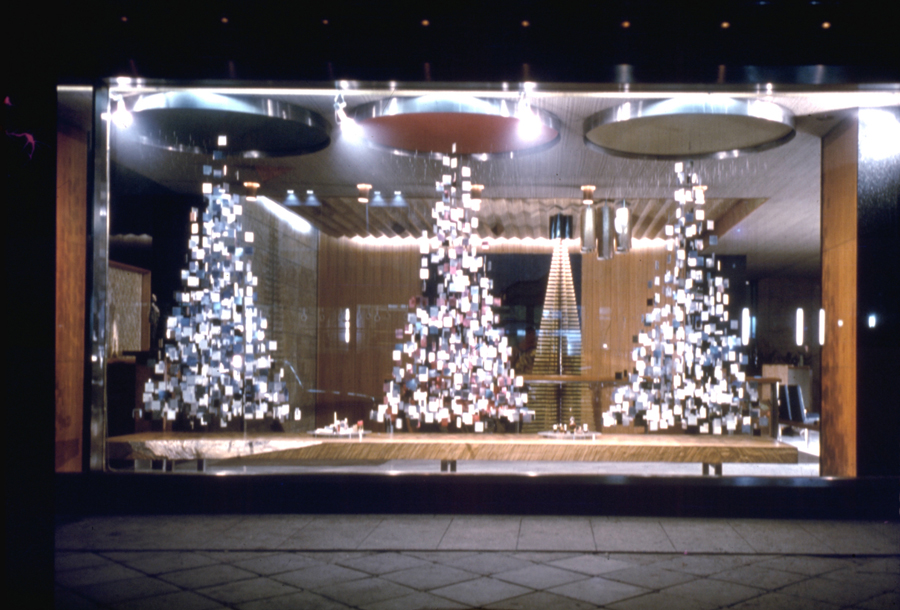
Show-window display design for Shiseido Kaikan (1963)
ー Do you still have video footage of Shiseido Kaikan's show window display designs?
Ito No, there was no video yet. The photographs appear in "Ito Takamichi 1960-2005", MOV(2006), a collection of works I produced on the occasion of my retirement from the University of the Arts. Generally, show windows have a wall at the back and are completed only within that space, but in the case of Shiseido Kaikan, there is no wall at the back and there is a passageway at the back, so people can pass through. So it has to be a work that can be seen 360 degrees in three dimensions. For Christmas, I hung an aluminium plate from the ceiling using tegus. It spins round and round and looks like it is glistening. There are also works using a marking pin, with various coloured marking pins that spin round and round. I still use the marking pins in my artwork. Many people came from all over to see this show window. One time, something interesting happened. Two girls sitting next to me on the train were talking, "Have you seen this month's Shiseido Kaikan?" They were talking about it. I was happy. They didn't know me, of course. Some people seemed to visit every month, and I received a lot of media coverage and various awards, such as the Mainichi Design Award and the ADC Award.
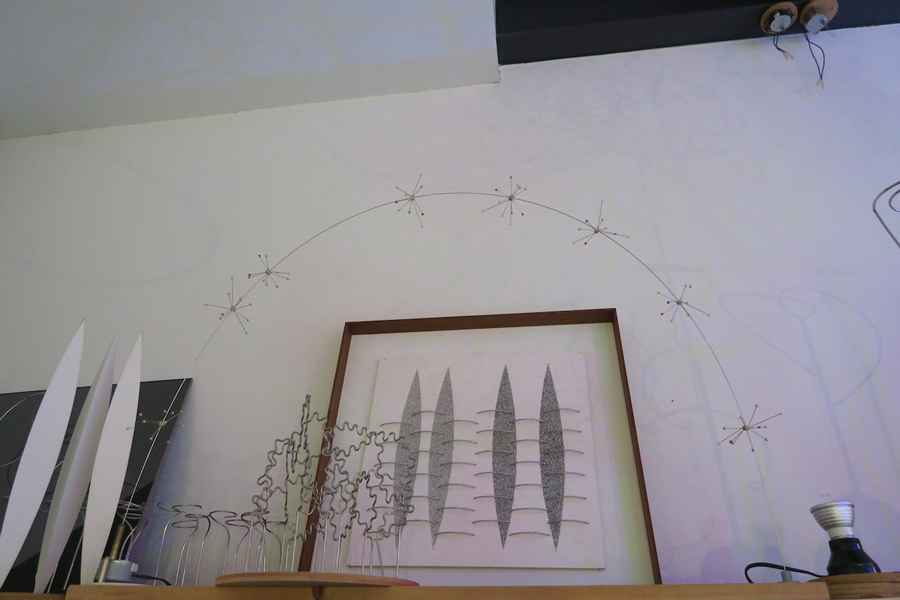
A prototype using a town needle, displayed in the studio.
ー The photograph on the next page shows the basement exhibition in the Theme Pavilion that he worked on at the Japan World Exposition, Osaka. Mr. Taro Okamoto was appointed as the producer of the exhibition, and various young people were brought together, of whom Mr. Ito was the youngest. It was interesting to read in "Taiyou no tou Okamoto Taro to 7 nin no otokotachi 48 nenme no tanjouhiwa (SEISHUN PUBLISHING, 2018)" about the contents of the exhibition at that time and the contentious exchange between Mr. Ito and Mr. Okamoto. I understand that Mr. Ito was in your twenties at the time and a successful artist, organising exhibitions for Shiseido kaikan's show windows and the Sony Building.
Ito I don't know why I was invited to be part of the theme pavilion for the Expo'70, but I was in my 20s at the time and Mr. Taro Okamoto was in his 50s. It wasn't a fight, but when I gave a presentation to Mr. Taro, we disagreed and I said something like, "That's not the time anymore" to him, and he got angry.
At the time, I didn't think I was a big seller at all. I was just desperately doing what was in front of me and what I had to do. After graduating from university, I started designing show-window displays for Shiseido kaikan in 1962, and then in 1966 the Sony Building was built in Ginza, and I was involved in the design of various displays for TOYOTA MOTOR CORPORATION, TORAY INDUSTRIES and other companies housed in that building. Together with media artist Mr. Katsuhiro Yamaguchi, we also held an exhibition called "International Psytech Art Exhibition Electromagica '69" at the Sony Building in 1969, the year before the Expo'70. Sony was the sponsor and various companies cooperated, JAL brought in works by overseas artists, Mr. Eiko Ishioka made the posters, and it was a large-scale exhibition using the entire Sony Building
ー Did kinetic art first appear in Japan around the 1960s and spread around Mr. Ito and Mr. Katsuhiro Yamaguchi? I think it was a ground-breaking thing to bring movement to art that had not moved before, and to change the light. I think you have pioneered this world, but was Alexander Calder a major influence?
Ito Mr. Yamaguchi is a technology arts person, isn't he? In addition to Calder, I also had a yearning for stage design when I was in high school, and I think my experience of creating stage sets for theatre had a big influence on my later life. My parents' restaurant had a small stage on which the neighbours would gather to practise dancing, and my father would do funny, theatrical things. I became interested in stage sets. My older brother was doing theatre in the theater club, and he used to ask me to come and help him. The head of the theater club at that time was Mr. Kan Ishibashi, a well-known person who became a director at NIPPON TELEVISION and later became a freelance director. I helped with the set design and lighting direction. I received various individual awards and won the first prize in a competition for high school students in Sapporo. We had to rent places like the Civic Hall and the Toyohirakan for our plays, but we had to ask a truck forwarder to do it for us because it was too expensive, so we loaded the equipment onto a horse-drawn carriage from school and everyone rode in the carriage with us. In those days, most of the transport in Hokkaido city was by horse-drawn carriage. The roads were covered with horse manure. In spring, when the snow melted, coal ash and horse manure would fly up in the air. In winter, all the houses used coal, so the air quality was bad. That was the time. In the 2000s, I worked on stage design for Japanese music and opera at the Sogakudo of the Tokyo University of the Arts.
In the course of this stage design experience, I knew that I wanted to become a stage designer in the future, and 50 years later my dream came true. In the 2000s, I worked on stage design for Japanese traditional music stages and operas at the Sogakudo of Tokyo University of the Arts. Stage design, show window displays and contemporary art are all connected in my mind as expressions of the same dimension.
The theme of the work is "Light"
ー All the works in your studio are in motion. I listened to an archived interview with Mr. Kinya Tagawa, a design engineer, and Mr. Yasuhiro Suzuki, an artist, by the JAPAN DESIGN COMMITTEE, in which they discussed the idea that nature is always in motion and that it is unnatural for objects to stand still while the leaves fall and the sun changes. It was interesting to hear that Mr. Ito's work is also in motion.
Ito Everything in nature is in constant motion. It has been going on for hundreds of millions of years, and nothing stands still. I feel this especially when I come to this atelier. Throughout the year, the scenery changes from season to season. I sense a shifting movement, depending on the time of day.
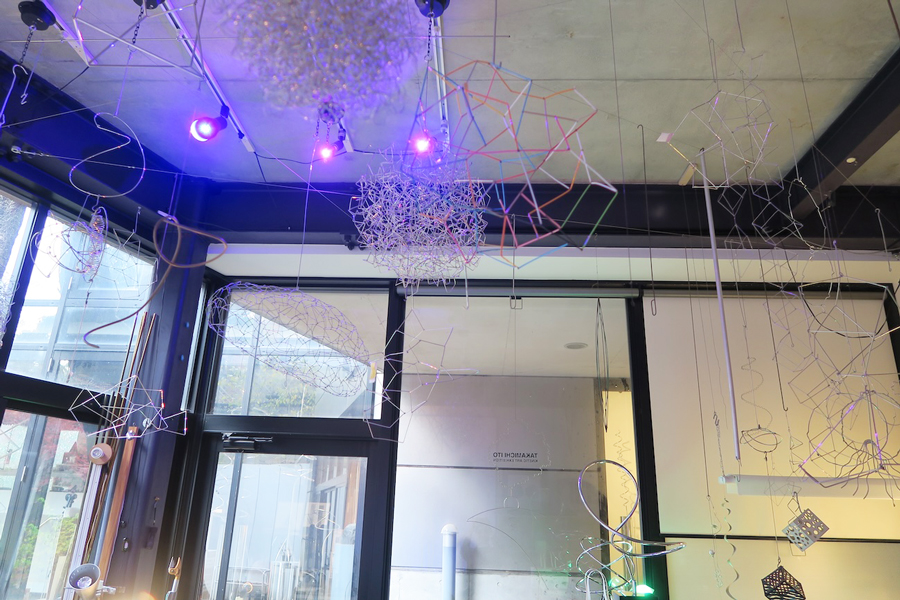
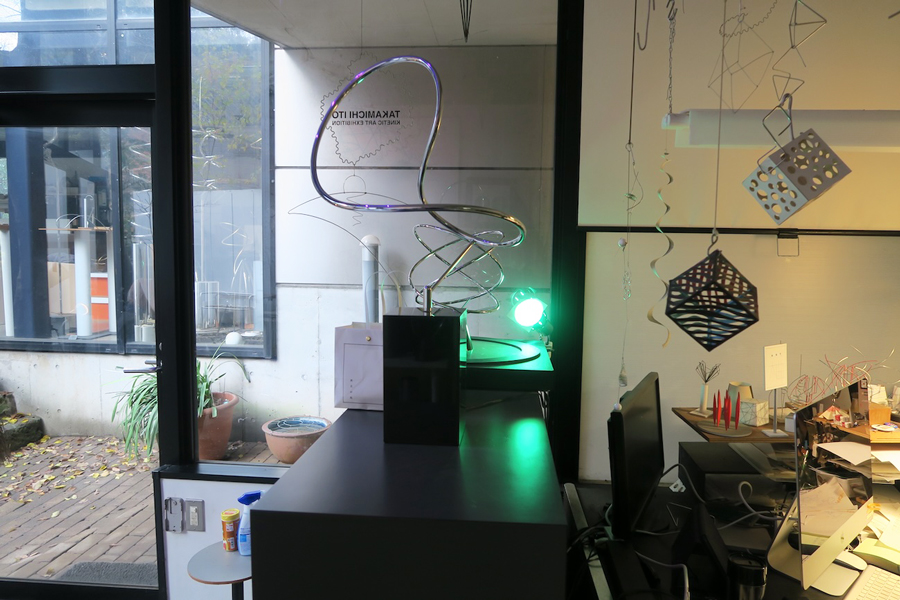
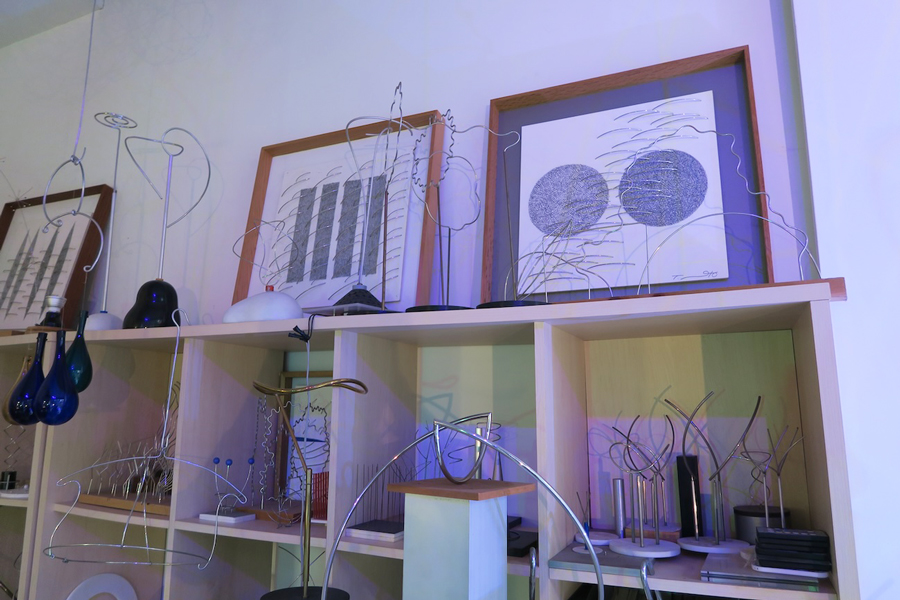
The works of art that Mr. Ito creates every day are everywhere, all of which are slowly rotated by a motor.
ー How fast are the pieces rotated?
Ito Basically, four revolutions per minute. It's about the same as the tempo of a person walking slowly. It varies depending on the size of the work, but for small works it is about 10 revolutions per minute, and for large works it is about three revolutions per minute. If something too big rotates too fast, you can't get close to it because you're scared. So we vary the speed of movement depending on the space or space in which they are installed. For me, the speed of rotation is another important expression.
ー Is the direction of rotation determined as clockwise or counterclockwise?
Ito The rotating movement can be clockwise or anti-clockwise, but it is important to note that the shining part of the line or pipe, the reflected light, goes up or down. It's more about the shiny part of the work, whether the light goes up or down. Light is a theme in my work. Chrome plating and stainless steel materials can produce these dots of light.
When I first discovered this, I was very impressed and started using these materials. I always move the work around, as if I'm doing it to move the glowing dots. Light, the shape of the spiral and its movement - that is the theme I am pursuing.
My interest in light originally started when I was a student and saved up money from my part-time job to buy a YAMAGIWA pendant lamp. I really wanted a Scandinavian one made in Denmark, but they were too expensive and out of reach, so I gave up and bought a domestic one.
ー Hokkaido, like Scandinavia, is at a high latitude and has long, dark winters, so I guess there is a sense of realising the beauty of light even more. I also lived in Sapporo as a child, so I still remember the beautiful snowfield scenery that sparkled in my mind.
Ito When the sun's rays hit the snowfields, they reflect and glow. The sky is dark blue and the ground is white, so the scenery is reversed in the winter season. At night, the light from the street lamps is beautiful again, and it's a fantasy world. In winter, it's completely white and sterile. All the germs and insects disappear. I thought that kind of sterile world was very nice. The southern regions are also warm and nice, though. If you go to the desert, it's a sterile world again. The original experience of today's children is probably in the world of games. They don't play outside much.
ー When it comes to light, you were involved in the launch of the LD Yamagiwa Laboratory when you were in your late 20s, whereas the TL Yamagiwa Laboratory was run by Mr. Kaoru Mende, who specialised in the technical aspects of light, and the LD Yamagiwa Laboratory specialised in light design. What was your motivation for setting up this research institute? Can you tell us why you set up this research institute?
Ito The architect Mr. Minoru Takeyama graduated from Sapporo Minami High School and was a classmate and friend of my brother. He went on to WASEDA University and Harvard University. He was working with YAMAGIWA before I was, and asked me to help out a bit, so I made a chandelier. From there, I started working for YAMAGIWA and was involved in planning international lighting competitions, exchanges with overseas companies and designing large lighting fixtures for hotels and department stores. At that time, starting with the Expo'70, lighting design and the creation of light formations in architectural spaces were all the rage. At that time, when skyscrapers were starting to be built, I also participated in Mr. Isamu Kenmochi's Keio Plaza Hotel project and did many other things, but most of the big hotel projects involved light sculptures and figurative works.
Across the realms of design and art
ー Your world expanded when you started working not only in architectural spaces, but also in outdoor sculptures. Do you distinguish between being a designer and an artist? Or are there no boundaries between the two activities?
Ito There are no boundaries. When I was involved in the display design of the show windows of the Shiseido Kaikan, art critics used to visit Ginza often, and they seemed to have seen the Shiseido show windows along the way, and one critic saw the show window I had worked on and said, "You, this is art. I'll invite you to a sculpture exhibition and you should exhibit your work". I then began to exhibit my work at contemporary Japanese sculpture exhibitions, such as Contemporary Sculpture Exhibition at Suma Imperial Villa, Kobe in Hyogo Prefecture and the UBE Biennale (International Sculpture Competition) in Yamaguchi Prefecture. I also received various awards there. I also received various awards there. At that time, one artist was introduced every month at the front of BUNGEISHUNJU, and I was featured in both the art and design sections respectively.
ー Do you sometimes feel that you lean more towards one or the other depending on what you make? Do you sometimes feel that you are a designer after all?
Ito I leave things I create to the viewer rather than how I see them myself. The only difference is whether the work is presented in a show window or in a museum or gallery - the expression of the work is exactly the same. One of my professors at university was researching the idea that it was Takamichi Ito who collapsed the boundaries of genres in the 1960s. I read that paper, and it was interesting. Nowadays the boundaries between genres are breaking down even further, but I think I may have been a pioneer in this regard.
ー I think it is an article by Ms. Keiko Hashimoto, Associate Professor at the Faculty of Architecture, KINDAI UNIVERSITY, entitled "The Significance of the 1960s Genre Deconstruction Movement in "Ito Takamichi no interia obujekuto nimiru 1960 nendai no janru kaitaiundou no igi", published in the academic journal "Bigaku" (the Japanese Society for Aesthetics, 2017). I would like to ask you about the 60s: what were the activities of "Sandwich Silencer" (members: Katsumi Asaba, Noriaki Kano, Shiro Kuramata, Keisuke Nagatomo, Seitaro Kuroda, Takamichi Ito, etc.), which was formed in 1969 and of which you were one of the members?
Ito The Nissenbi (Japan Advertising Artists Club) was established in 1951 and was a gateway to success for new designers, holding exhibitions throughout the country and inviting entries from the public. Everyone worked very hard and just when they thought they had finally become a member, the Nissenbi was dissolved in the wake of the student movement. Everyone had nowhere to go. So we got together and decided to do something, and I was told to join. One day, we all got together and went to the rooftop of the SEIBU SHIBUYA, and afterwards we went to Asakusa for drinks. It was a group of first-year Nissenbi students. I feel like we created our work individually and lived in the same period as a common consciousness. I was involved in a lot of different genres at the time.
ー There’s a group photo of the Silencer’s friends taken on the tennis court, isn’t there?
Ito That is Lake Yamanakako, isn't it? Mr. Yusaku Kamekura first created a second house on Lake Yamanakako for weekend enjoyment away from Tokyo. Then I built mine, and then I said, "If Takamichi Ito can build it, then I can too", and built them one after another. We had tennis tournaments during the summer holidays, and at New Year's we would have mochitsuki (mochi pounding). But the fact that so many people were building a second house at the time meant that the economy was booming. Later, I built a atelier in Hokkaido, so I was the first one to leave Yamanakako. I wanted a large studio where I could make things, because I thought that making, or manual creativity, was important. As our children grew up, we gradually stopped going to Lake Yamanakako.
ー The people who were active in the 1960s were richer than today's designers, weren't they?
Ito That may be true. They all had cars too, because they drove to Lake Yamanakako. It was a time when there were many individual designers and before the rise of large organisations after the Expo'70, and the quality of design was very different from today.
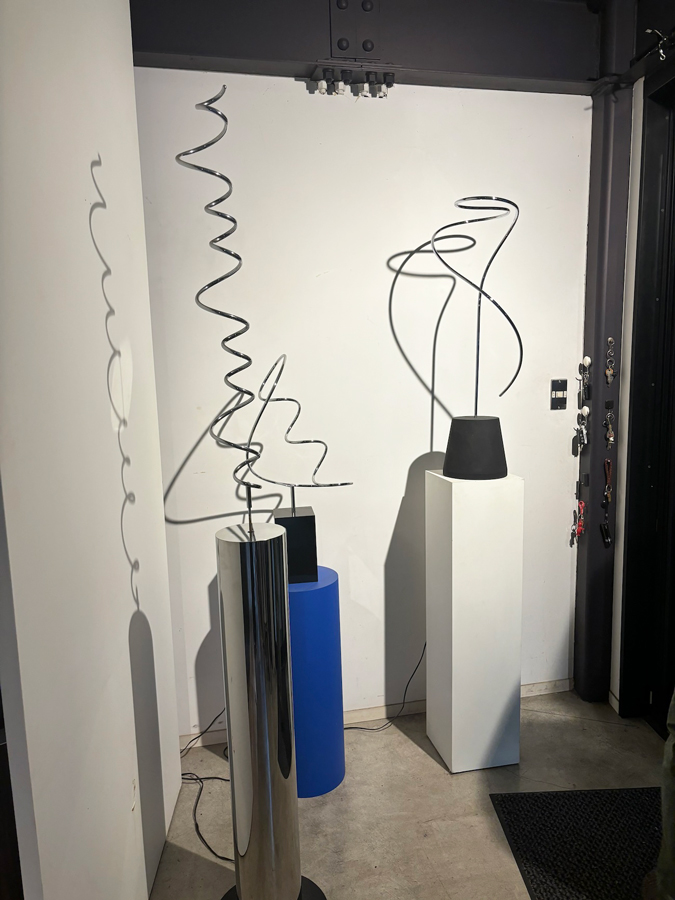
The wing next to the atelier is lined with large works of art.
ー There are also a lot of works in the building next to your atelier, do you also sell your works?
Ito No, in my case, I didn't present and sell my creations in solo exhibitions or galleries, but I often received orders to make them when some public facility was built or when they were installed in a public place. I think about what to do with the given environment, where and how to place them. So that is a designer's way of thinking. But nowadays, I think all artists think like that, too.
ー In "Talking with "Tukuru jutsu nitsuite 5 nin no dezainatachi to katatta – Miyawaki Mayumi taidansyu (Shinkenchiku-Sha, 1983) ", it is written that while Mr. Taro Okamoto and Mr. Shintaro Tanaka have the idea of confrontation and fighting when creating their works, Mr. Ito thinks about blending into the environment. At the time, Mr. Kenzo Tange built the Tokyo Metropolitan Government Building, and Mr. Taro Okamoto, who worked on the walls of the building, said of Mr. Tange's architecture that it was "confrontational and quarrelsome". You had this thought. "I once had a simple question: why should there be a confrontation? I was thinking very seriously at the time that it would be good if the relationship between the two sides could be more harmonious, or if they could come together. (snip) At the time, I had a strange theory that a form without form was the most compatible form, and I kept sticking to it, and that is how I created my own form".
Ito I really like the word "fusion". I have had "fusion" in mind since I was a student. That's why I had a fight with Mr. Taro Okamoto at the time of the Expo'70. I don't know which is better or worse - to bump into the environment or to integrate it. As Mr. Isozaki said, my liking for fusion may also have something to do with the fact that I grew up in a northern country. It's like the difference between Italian design and Scandinavian design. In contrast to Italian design, which has a strong assertiveness, Scandinavian design has no assertiveness, but often uses natural materials, so it blends in with the surrounding environment without being overpowering. The conflict between Catholics and Protestants was also analysed by Mr. Isozaki as a result of the different characteristics of the climate.
ー In terms of "environment", was there already a term for environmental art in Japan in the 60s and 70s?
Ito The term "environmental art" emerged in the 60s and was difficult to translate in Japanese, so eventually the word environment became environment. However, at the time, the word "environment" in Japan had a strong impression of environmental sanitation, and is now understood to mean the public environment. Perhaps it was at the Matsuya Ginza "From Space to Environment" exhibition in 1966 that the term "environmen" began to be recognised.
ー The "From Space to Environment" is said to be a historic exhibition, with a total of 38 diverse creators from architecture, design, photography, painting, sculpture and music, and was visited by around 35,000 people over six days.
Ito It was an amazing exhibition. There is a sense that this enthusiasm grew in size as it moved on to subsequent events such as Electromagica'69 and the Expo'70.
Thinking by hand and while building with wire
ー I would like to start by asking you about archive materials. There are no design museums in Japan today, and it is a problem that after designers pass away, their works and materials are scattered or lost. The second objective of this interview is to find out what kind of artworks and materials you have and what kind of condition they are in. Graphic designers leave behind printed matter and prints, but in your case, what kind of material do you have? For example, sketches or drawings?
Ito I don't have any sketches. I think there are drawings if you look for them, but they were made by the staff. I don't start with a sketch. I don't draw sketches first, but always use wire, bending it with my fingers or pliers and thinking about it as I make it. In a way, this wire is my pencil. This is a spoon for scooping small pieces of chocolate made of wire, which was exhibited when the Ginza mekiki Hyakkaigai "T.ITO-YA Ginza Store" was held at Matsuya Ginza in 2019. I will give it to you both.
ー Thank you very much! It's very easy to scoop.
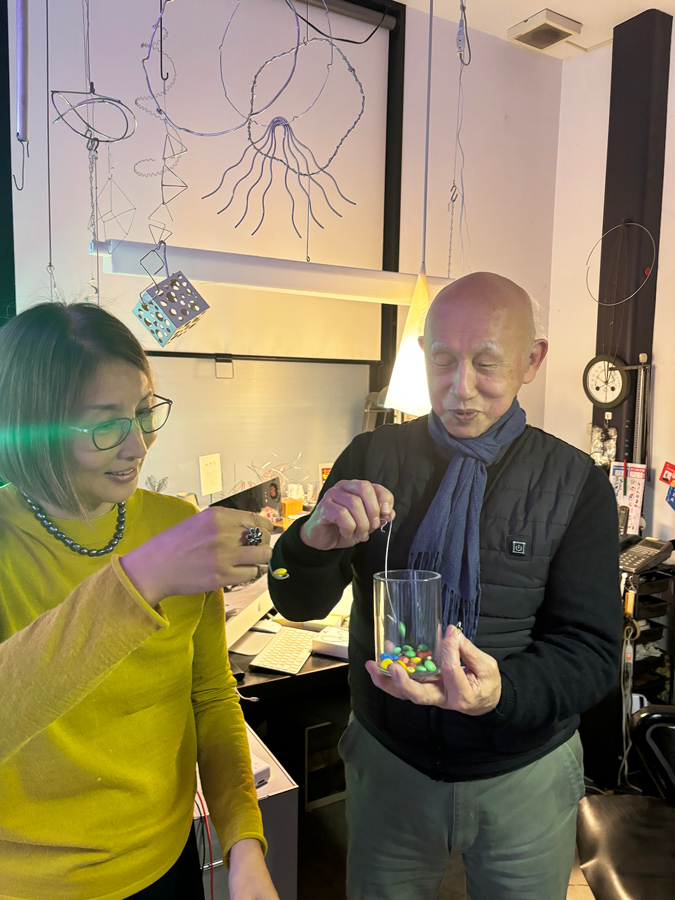
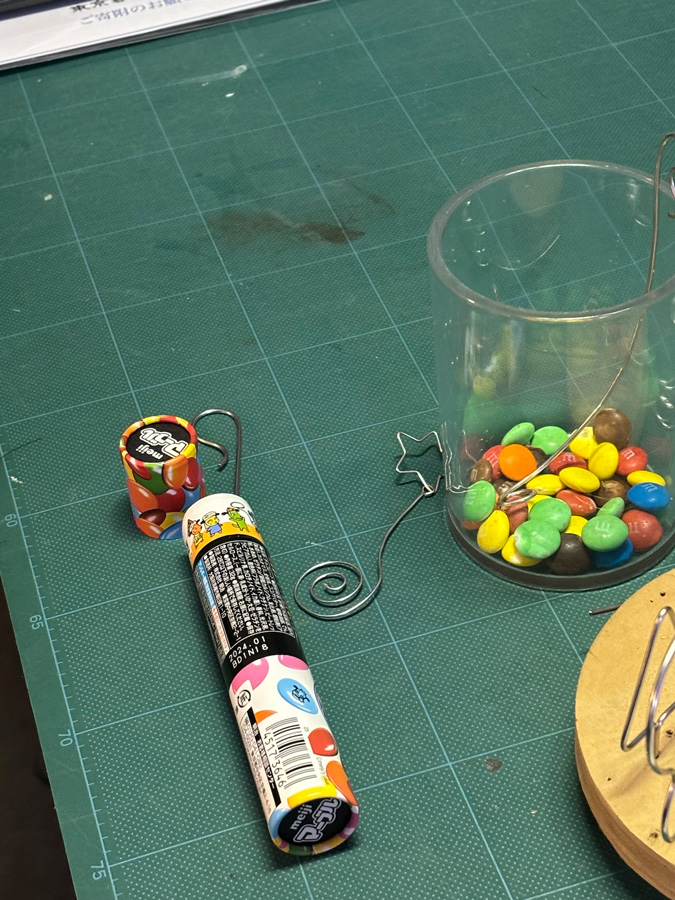
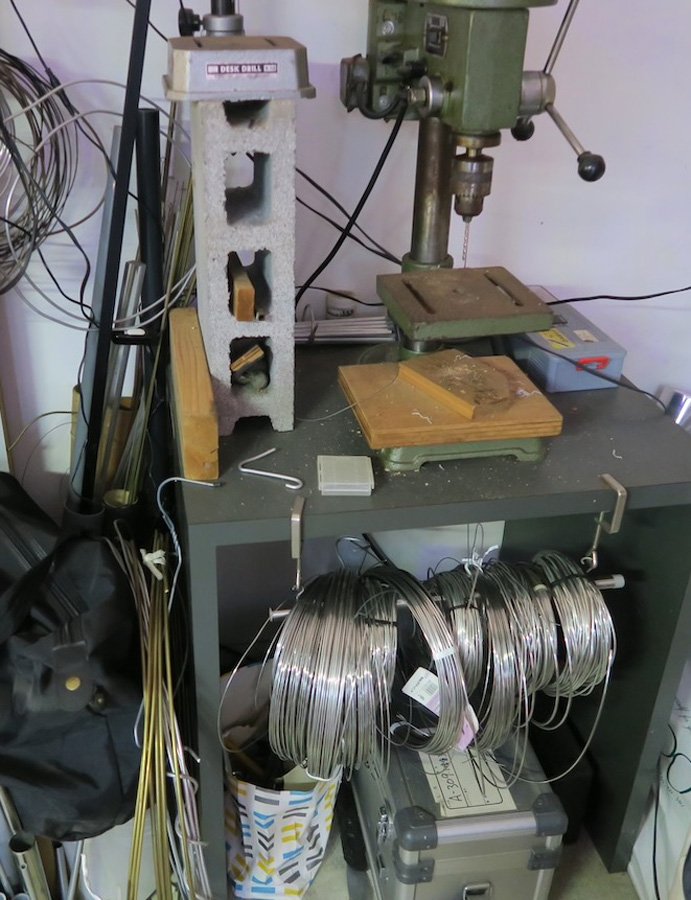
Scooping chocolate with a spoon created by Mr. Ito. The wire comes in a variety of different thicknesses.
Ito I always think about it while making the model with wire like this, and when I present it to the client, I make the model of the entire space myself, although I outsource the work for larger pieces. I also think about the size of the building and the garden, and I always try to actually put them in place and move them around. I
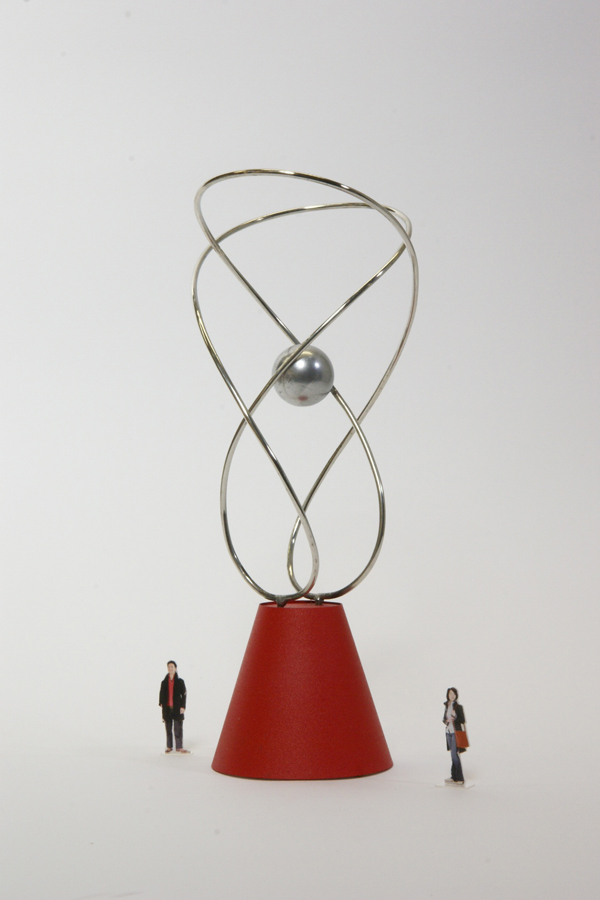
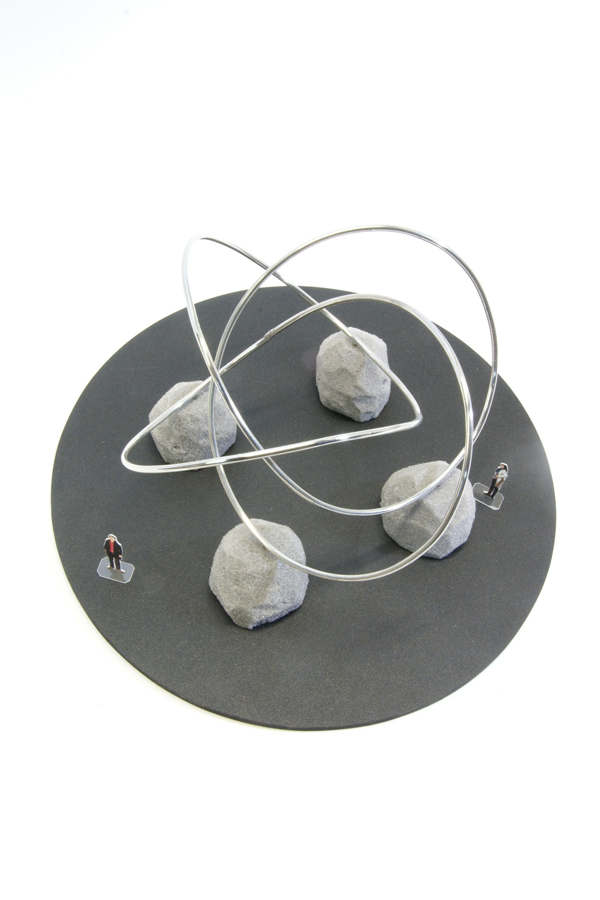
Models for submission to the factory.
Ito There was a workshop in the basement of the building next to the atelier, where I made models. Because it was in the basement, even if we made noise, it wouldn't be heard very much by the people around us. I had quite a few models, but they were old and I had to destroy most of them. The factory workers also build the models, not just from drawings and sketches. Only the size and number of revolutions are important, so I have that in the data. The people at the factory don't work from drawings or sketches, but from the models. Subtle curves and other features that cannot be seen in drawings can often only be conveyed in three dimensions.
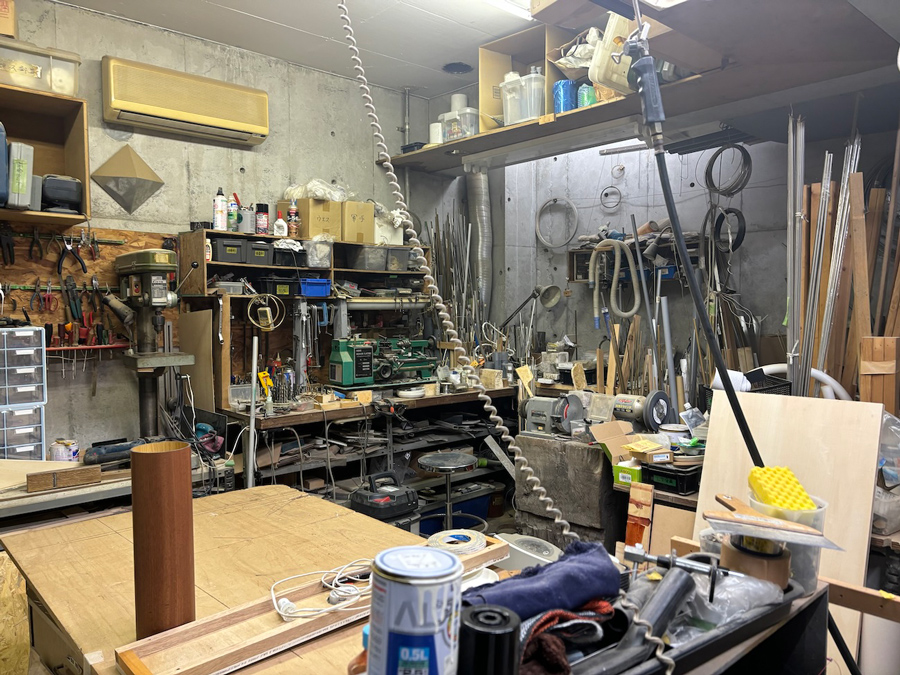
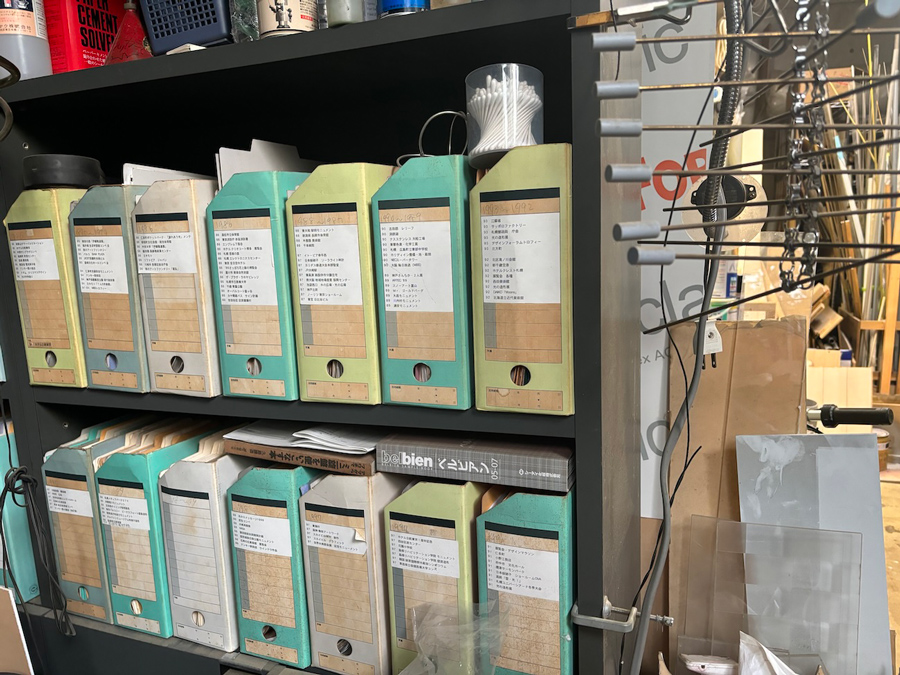
Basement workshop in the building next to the atelier. There is also a file box with a collection of materials.
ー The original drawings and models by Mr. Ito, Mr. Motomi Kawakami and others exhibited in the "Secret Source of Inspiration: Designers' Hidden Sketches and Mockups" at 21_21 DESIGN SIGHT had a handmade feel to them that I really enjoyed. However, most of the recent works by young designers looked like computer output. The computer-generated works were beautiful, but it doesn't get to the heart. Through that exhibition, I strongly felt the power of what is created with the hands.
Ito I still think we need to think fundamentally about creating art again: the term CG is no longer used, and there is a lot of talk about AI now, but I don't think even AI can match nature. The natural world is amazing.
ー I think so. I would also like to ask you about your website - I am impressed by how well organised it is. Is it maintained by your son?
Ito I don't know. Maybe it was made based on the data from the book I made for the retirement exhibition. I think I compiled the works and chronology at that time. I haven't organised or managed it myself at all.
ー I know you have a lot of photos on your website, but do you always decide which photographer you want to take them?
Ito No, I haven't decided. If there is a sponsor, the sponsor often takes the photographs. When there was a magazine "JAPAN INTERIOR DESIGN", Mr. Mitsumasa Fujitsuka photographed my work. My wife keeps the issues in which my work appears. But I'm not really interested in the media in the way that I want to have my work published in magazines.
ー It's better to have people see the real thing in motion than the two-dimensional thing, isn't it?
Ito Yes, that's right. I don't have much feeling for materials, but I do want people to see the actual work. I believe that three-dimensional works and spaces cannot be conveyed unless they are seen in person.
ー Their holdings include the National Museum of Modern Art, Kyoto and the he Hokkaido Museum of Modern Art - does this mean that they are environmental sculptures installed in museums?
Ito Some of them are no longer there, though. The Toyama Prefectural Museum of Art and Design has been renovated, so my sculptures are no longer there. Yesterday, I went to the Hakone Open-Air Museum. I guided a person who is on the organisers of the Lih Pao International Sculpture Biennial Awards in Taiwan. I'm going to be the president of the jury next time. There are many internationally renowned people in the Japanese art world, but the mood is relatively stagnant at the moment. Young people in China and Taiwan seem to be thinking about what's next. There is a law to include 1% art in architecture and urban planning, so all sorts of creators are coming up. Taiwan is vibrant because of that, and in China a lot of sculpture parks and sculpture museums are being built. Recently, the Hohhot Sculpture Art Museum was built in Inner Mongolia, a city with a population of about two million, and I was invited to the opening ceremony and exhibited a work. In recent years, I have been increasingly invited to exhibitions in China and Taiwan like this, and I also serve as a juror for sculpture exhibitions.
ー That is the situation in China and Taiwan at the moment. When you were teaching at the Tokyo University of the Arts, how were the young Japanese people?
Ito At the time, we set up an information processing center on campus, and I became the first director of the center, and we introduced digital and arts education in the arts. However, it was not yet the full-fledged computer age, and I got the impression that many teachers did not respond well to it.
My son's children are students, and it seems that people of that generation are beginning to move towards creating a new world of expression. Now, I think we need to think fundamentally about making artworks again, about what is not in the digital world, about nature and air. The term "CG" is no longer used, and now we are talking about AI, but I don't think even AI can match nature. The natural world is amazing. I would also like to create something that is different from the past, but that is different from what the young people of today are doing, although it would be strange to say that it exceeds what the young people of today are doing.
ー The original drawings and models by you, Mr. Kawakami Motomi and others in the "Secret Source of Inspiration: Designers' Hidden Sketches and Mockups" at 21_21 DESIGN SIGHT had a handmade feel to them that I really enjoyed, but most of the stuff by younger people in recent years looked like computer output. I strongly felt the power of things created by hand through that exhibition. Books are one way for designers to communicate their ideas and thoughts to younger generations, but the other day you mentioned that you are not really interested in writing books.
Ito I'm not really interested in it. I don't like writing, or I wonder if there is really any point in making a book. I don't like writing, or rather, I feel the limitations of communicating with words, and I wonder if there is really any point in making a book? I also wonder. For the Shiseido kaikan’s show windows, I came up with the concept afterwards for the presentation, after everything was completed.
ー When I spoke to you today, I got the impression that you have aspects of design and art coexisting in your work. The work is basically made on commission, which can be described as design work, but what is made is a one-off product, like an artist, and differs from a designer who presents his work at exhibitions and solo shows and makes mass-produced products. When I talk to designers who have graduated from Tokyo University of the Arts, I get the impression that many of them genuinely love making things, compared to those who have graduated from other art universities.
Ito By the way, this summer the Hakone Open-Air Museum will celebrate its 55th anniversary. Since its opening, the "16 Rotating Bent Stick" piece has remained the centrepiece of the museum's collection, 55 years later. For the first time in 45 years, the "Rotating Rings with Curved Lines" will be on display for this 55th anniversary. It was installed in 1975 and went into storage when the museum was renovated and the works were replaced, but the curator said he wanted to display that work again for the 55th anniversary. I think it has been re-introduced as a work that fits in with the current times. It is a great pleasure to exhibit in a museum of international repute with hundreds of thousands of visitors a year. I am deeply moved by the fact that the exhibition will be on display again, from the 1970s to the present day and through the ages.
ー That's something to look forward to. Thank you very much for your valuable talk today.
Enquiry:
http://www.mov-art.co.jp/takamichi/

